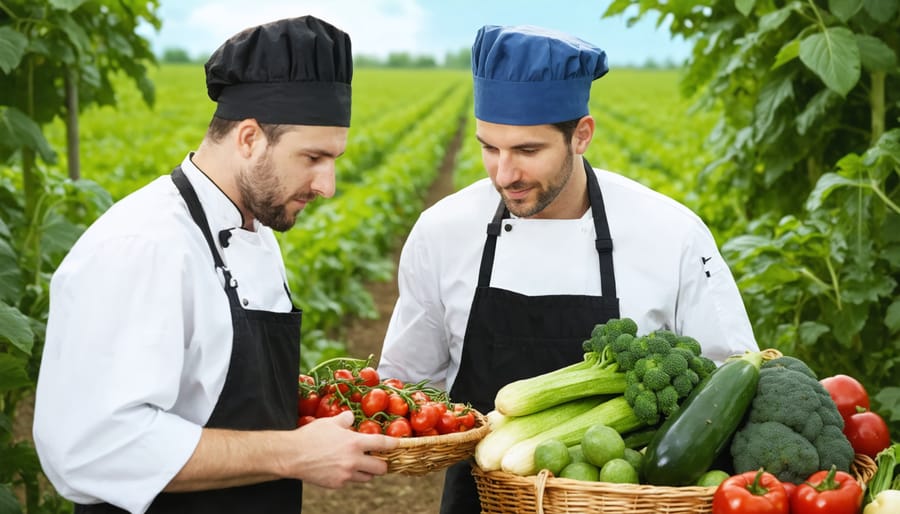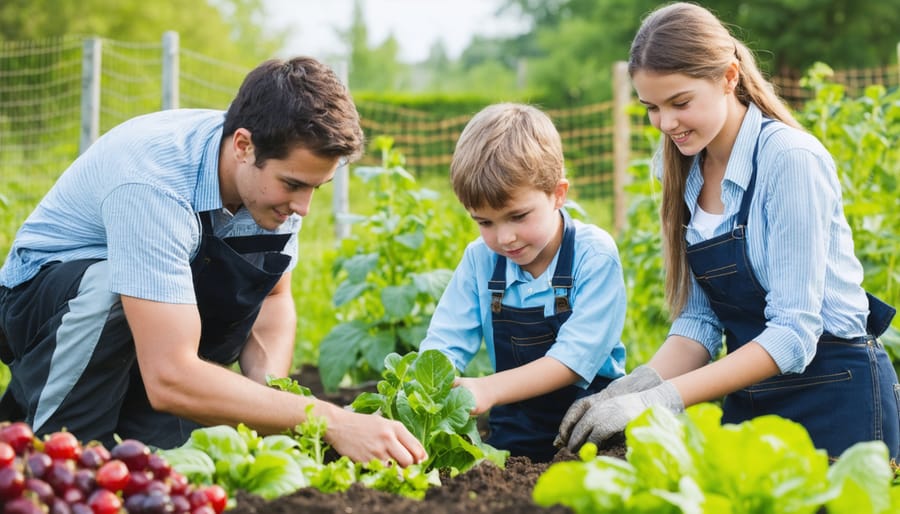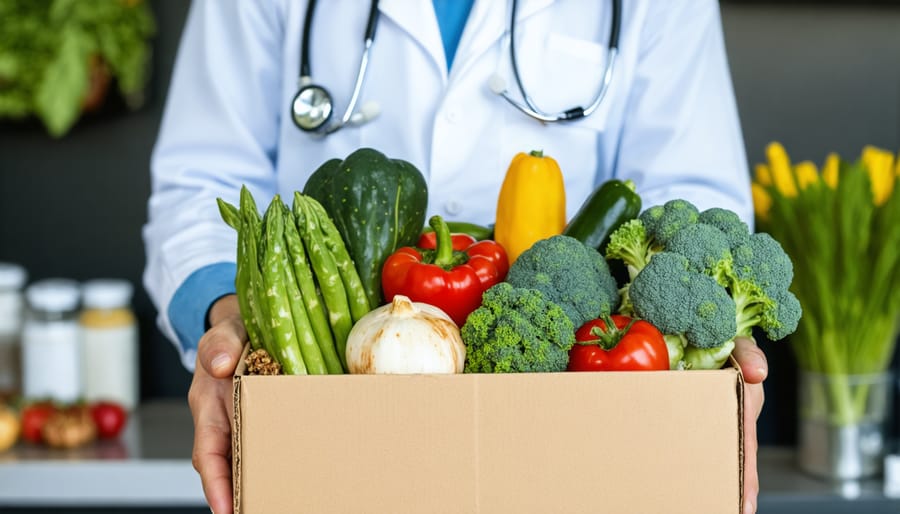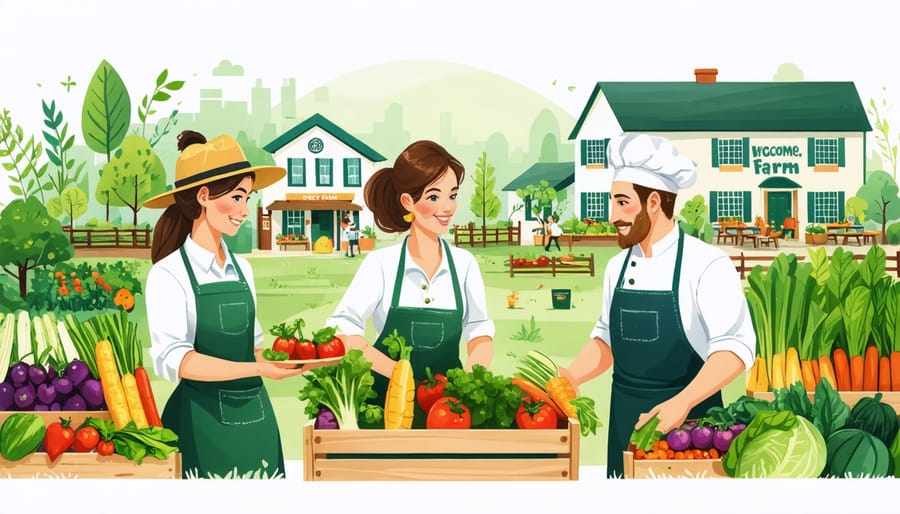How Local Farms Are Creating Powerful Partnerships That Transform Communities
Cross-sector collaborations transform fragmented agricultural initiatives into powerful sustainable local food systems through strategic partnerships. When farmers join forces with local restaurants, schools, and community organizations, they create resilient distribution networks that benefit everyone involved. These partnerships amplify impact by combining resources, sharing knowledge, and expanding market reach far beyond what any single organization could achieve alone.
Small-scale organic farms partner with food banks to distribute surplus produce, while restaurants commit to seasonal purchasing agreements that provide farmers with stable income streams. Educational institutions integrate farm-to-cafeteria programs, teaching students about nutrition while supporting local agriculture. Technology startups collaborate with farming cooperatives to streamline logistics and reduce food waste through innovative distribution solutions.
This interconnected approach doesn’t just strengthen local food security – it builds lasting relationships that spark innovation, share risk, and create economic opportunities across sectors.
Building Bridges Between Farms and Local Businesses

Farm-to-Table Restaurant Partnerships
The partnership between Blue Hill Farm and The Harvest Table Restaurant exemplifies the power of farm-to-table collaboration. This dynamic duo has created a sustainable food system that benefits both businesses while delighting diners with ultra-fresh, seasonal ingredients. The restaurant’s chef works directly with farmers to plan seasonal menus six months in advance, ensuring crops are grown specifically for their kitchen’s needs.
Another success story comes from Green Valley Organics and Bistro Fresh, who developed an innovative sharing system. The restaurant invested in greenhouse infrastructure at the farm in exchange for priority access to premium produce. This arrangement helped the farm extend their growing season while giving the restaurant a reliable year-round supply of local vegetables.
The Portland Food Alliance demonstrates how these partnerships can scale up. Their network connects 15 local farms with 30 restaurants through a cooperative distribution system. This model has reduced food waste by 40% and increased participating farmers’ revenue by an average of 35%.
These collaborations work best when both parties maintain open communication, establish clear expectations, and share a commitment to quality and sustainability. Regular farm visits by restaurant staff have proven essential for building lasting relationships and understanding each other’s needs and capabilities.
Local Grocery Store Integration
CSA farms are increasingly partnering with local grocery stores to create win-win scenarios that benefit farmers, retailers, and consumers alike. These partnerships typically involve dedicated shelf space or display areas for CSA produce, allowing farms to reach customers who might not otherwise participate in traditional CSA programs.
Many successful collaborations feature weekly produce deliveries to partner stores, where subscribers can pick up their shares at their convenience. This flexibility helps overcome one of the main barriers to CSA participation: rigid pickup schedules. Some stores even offer “mix-and-match” options, allowing customers to customize their selections from the available CSA produce.
For example, Green Acres Farm in Vermont partners with three local markets, providing fresh produce displays that are clearly labeled as locally grown. They’ve found that store presence has increased their CSA membership by 40% while helping partner stores attract more foot traffic.
These partnerships often extend beyond simple retail arrangements. Many stores collaborate with farms for seasonal events, cooking demonstrations, and educational programs that highlight the benefits of locally grown produce and sustainable farming practices.
Educational Partnerships That Grow Community Knowledge
School Garden Programs
As farms and schools join forces, they create powerful educational opportunities that benefit both students and local agriculture. These partnerships typically involve establishing school gardens where students learn hands-on farming skills, nutrition, and environmental stewardship. Farmers contribute their expertise by visiting classrooms, leading workshops, and helping maintain the gardens throughout the growing season.
Students participate in planting, harvesting, and preparing fresh produce, developing a deeper connection to their food sources. Many programs incorporate curriculum elements covering science, math, and environmental studies through practical garden activities. Some schools even create mini CSA programs, where students manage small-scale vegetable production and distribution to their families.
These collaborations often extend beyond the garden, with field trips to local farms, cooking demonstrations, and seasonal harvest celebrations. The impact reaches far beyond the classroom, as students share their knowledge with family members and become advocates for sustainable food systems. For farmers, these partnerships help cultivate the next generation of agricultural leaders while building strong community connections and potential future CSA members.

Community Workshop Initiatives
Community workshops have become a cornerstone of successful cross-sector collaborations in sustainable agriculture. These educational programs bring together farmers, local businesses, and community members to share knowledge and build lasting partnerships. Many CSA farms now host monthly skill-sharing sessions where experienced farmers teach sustainable growing techniques alongside business professionals who share marketing and financial management expertise.
Local chefs frequently participate in these workshops, demonstrating creative ways to prepare seasonal produce while helping community members understand the farm-to-table connection. These culinary workshops not only educate participants about cooking with fresh ingredients but also strengthen the relationship between restaurants and local farms.
Environmental organizations and master gardeners often contribute their expertise through hands-on demonstrations of composting, water conservation, and organic pest management. These practical sessions help both aspiring farmers and home gardeners develop sustainable practices they can implement immediately.
Workshop participants frequently report feeling more connected to their local food system and better equipped to support sustainable agriculture in their community. Many programs now include youth education components, creating opportunities for schools and agricultural organizations to collaborate in nurturing the next generation of sustainable farmers.
Healthcare Collaborations for Better Community Health

Prescription CSA Programs
Healthcare providers are increasingly recognizing the connection between nutrition and health outcomes, leading to innovative “produce prescription” programs. These initiatives allow doctors and healthcare professionals to write prescriptions for fresh fruits and vegetables from local CSA farms, making healthy eating more accessible to patients.
Participating healthcare facilities partner with nearby farms to provide patients with weekly or monthly shares of seasonal produce. Patients receive their prescribed CSA boxes at reduced or no cost, often supplemented by insurance programs or grant funding. Many programs also include nutrition education, cooking demonstrations, and seasonal recipe cards to help patients make the most of their fresh ingredients.
Success stories include diabetes patients achieving better blood sugar control and families developing lasting healthy eating habits. The Boston Medical Center’s Preventive Food Pantry program, for example, has served thousands of patients through their prescription CSA initiative, demonstrating how these collaborations can create meaningful health impacts while supporting local agriculture.
These programs represent a growing movement in preventive healthcare, recognizing food as medicine and creating sustainable partnerships between medical providers and local farms.
Wellness Program Integration
Corporate wellness programs are finding innovative ways to promote employee health through partnerships with local farms. These collaborations create win-win situations where farms secure steady customers while companies provide their employees with fresh, nutritious produce and meaningful connections to local agriculture.
Leading companies are incorporating farm-fresh produce deliveries into their wellness benefits, offering subsidized CSA shares or hosting regular farmer’s markets in their office spaces. Some organizations take it further by arranging team-building activities at partner farms, combining employee engagement with hands-on agricultural education.
These partnerships often include educational components, such as lunch-and-learn sessions where farmers share nutrition tips and cooking demonstrations using seasonal produce. Some programs even feature guided farm tours and harvest events that help employees understand where their food comes from while promoting mental wellness through connection with nature.
The results are compelling: improved employee satisfaction, reduced healthcare costs, and strengthened local food systems. Companies report higher participation in wellness initiatives when fresh, local produce is part of the program.
Technology Partners Expanding CSA Reach
Technology has become a game-changer for CSA farms, revolutionizing how they connect with members and manage operations. Innovative partnerships with tech companies are helping farms streamline everything from crop planning to delivery logistics, making fresh, local produce more accessible than ever.
Many CSAs now use custom mobile apps that allow members to manage their subscriptions, track deliveries, and even swap items in their weekly boxes. For instance, Fresh Farm Collective partnered with a local software developer to create an app that sends push notifications about harvest schedules and upcoming events, keeping members engaged and informed.
Online platforms have also transformed payment processing and member communication. Cloud-based management systems help farmers track inventory, automate billing, and maintain detailed customer databases. The Wright Family Farm in Oregon reported a 40% reduction in administrative time after implementing a digital management system, allowing them to focus more on growing food and less on paperwork.
Digital marketplace partnerships are extending CSA reach beyond traditional boundaries. Some farms have teamed up with food delivery services to offer flexible subscription options and expanded delivery zones. These collaborations often include features like real-time delivery tracking and automated recipe suggestions based on weekly box contents.
Social media integration through tech partnerships has helped CSAs build stronger communities online. Farms can easily share updates, post harvest photos, and host virtual farm tours. Many CSAs now use data analytics tools to better understand member preferences and optimize their crop planning accordingly.
These technological advances aren’t just making things easier for farmers – they’re creating a more convenient and engaging experience for members while maintaining the personal connection that makes CSA programs special.
Cross-sector collaborations offer a wealth of opportunities for farms to grow, innovate, and better serve their communities. By partnering with schools, restaurants, healthcare facilities, and other local businesses, farms can create sustainable revenue streams while making a meaningful impact in their communities. These partnerships not only provide financial stability but also help farms expand their reach, diversify their offerings, and build stronger relationships with customers.
Success stories from farms across the country demonstrate how these collaborations can transform small agricultural operations into thriving community hubs. From educational programs that inspire the next generation of farmers to workplace CSA programs that promote employee wellness, the possibilities are endless.
We encourage farms to take the first step by identifying potential partners in their community whose values and goals align with their mission. Start small, perhaps with a single partnership, and gradually expand as you build experience and confidence. Remember that successful collaborations are built on clear communication, mutual benefit, and a shared commitment to sustainable agriculture and community well-being.
By embracing cross-sector partnerships, farms can create resilient, sustainable business models that benefit everyone involved while strengthening local food systems for years to come.









